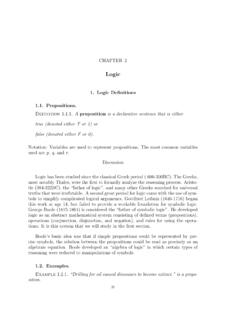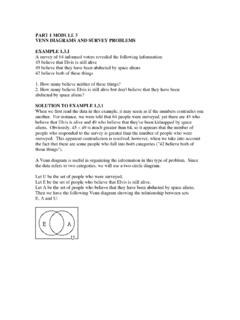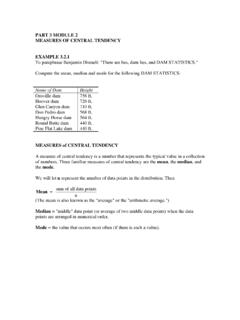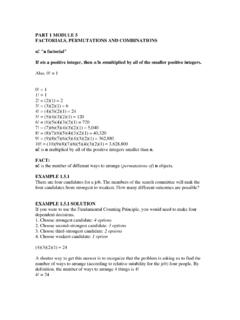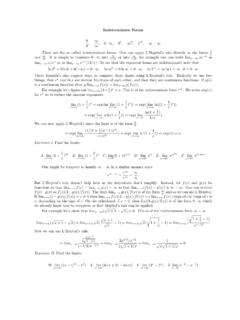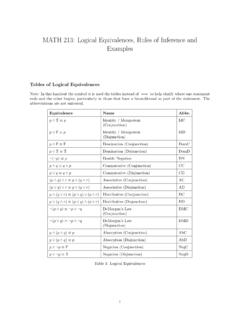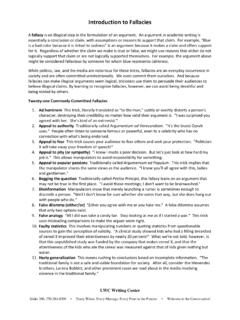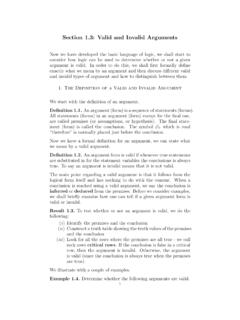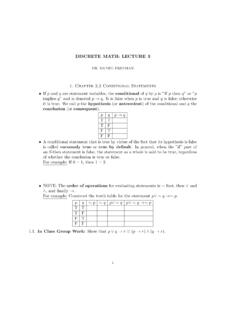Transcription of Methods of Proofs - Florida State University
1 CHAPTER 3. Methods of Proofs 1. Logical Arguments and Formal Proofs Basic Terminology. An axiom is a statement that is given to be true. A rule of inference is a logical rule that is used to deduce one statement from others. A theorem is a proposition that can be proved using definitions, axioms, other theorems, and rules of inference. Discussion In most of the mathematics classes that are prerequisites to this course, such as calculus, the main emphasis is on using facts and theorems to solve problems. Theorems were often stated, and you were probably shown a few Proofs . But it is very possible you have never been asked to prove a theorem on your own. In this module we introduce the basic structures involved in a mathematical proof . One of our main objectives from here on out is to have you develop skills in recognizing a valid argument and in constructing valid mathematical Proofs .
2 When you are first shown a proof that seemed rather complex you may think to yourself How on earth did someone figure out how to go about it that way? As we will see in this chapter and the next, a proof must follow certain rules of inference, and there are certain strategies and Methods of proof that are best to use for proving certain types of assertions. It is impossible, however, to give an exhaustive list of strategies that will cover all possible situations, and this is what makes mathematics so interesting. Indeed, there are conjectures that mathematicians have spent much of their professional lives trying to prove (or disprove) with little or no success. More Terminology. A lemma is a pre-theorem or a result which is needed to prove a theorem. A corollary is a post-theorem or a result which follows from a theorem (or lemma or another corollary).
3 56. 1. LOGICAL ARGUMENTS AND FORMAL Proofs 57. Discussion The terms lemma and corollary are just names given to theorems that play particular roles in a theory. Most people tend to think of a theorem as the main result, a lemma a smaller result needed to get to the main result, and a corollary as a theorem which follows relatively easily from the main theorem, perhaps as a special case. For example, suppose we have proved the Theorem: If the product of two integers m and n is even, then either m is even or n is even. Then we have the Corollary: If n is an integer and n2 is even, then n is even. Notice that the Corollary follows from the Theorem by applying the Theorem to the special case in which m = n. There are no firm rules for the use of this terminology; in practice, what one person may call a lemma another may call a theorem.
4 Any mathematical theory must begin with a collection of undefined terms and axioms that give the properties the undefined terms are assumed to satisfy. This may seem rather arbitrary and capricious, but any mathematical theory you will likely encounter in a serious setting is based on concrete ideas that have been developed and refined to fit into this setting. To justify this necessity, see what happens if you try to define every term. You define a in terms of b, and then you define b in terms of c, etc. If a, b, c, .. are all different terms, you are lead to an infinite chain of definitions; otherwise, one of them is repeated and you are left with a circular chain of definitions. Neither of these alternatives is logically acceptable. A similar criticism can be made for any attempt to prove every assertion.
5 Here are a few important examples of mathematical systems and their basic ingredients. In plane geometry one takes point and line as undefined terms and assumes the five axioms of Euclidean geometry. In set theory, the concept of a set and the relation is an element of, or , are left undefined. There are five basic axioms of set theory, the so-called Zermelo- Fraenkel axioms, which we will use informally in this course, rather than giving them a rigorous exposition. In particular, these axioms justify the set builder notation we discussed in Module : Sets and the existence of the power set of a set, which we shall discuss later in Module : Set Operations. The real number system begins with the four Peano Postulates for the positive integers, taking the elements, numbers, in the set of positive integers as undefined, as well as the relation is a successor of between positive integers.
6 (To say x is a successor of y turns out to mean that x = y + 1.) The fourth Peano Postulate is the Principle of Mathematical Induction, which we shall use extensively in the next module. From these modest beginnings, and with a little help from set theory, one can construct the entire set of real numbers, including its order and completeness properties. As with our treatment of set theory, we shall, with the one exception mentioned above, use these axioms informally, assuming the familiar model of the real 1. LOGICAL ARGUMENTS AND FORMAL Proofs 58. number line together with its important subsets, the natural numbers, the integers, and the rational numbers. Once we have the undefined terms and axioms for a mathematical system, we can begin defining new terms and proving theorems (or lemmas, or corollaries) within the system.
7 Formal Proofs . To prove an argument is valid : Assume the hypotheses are true. Use the rules of inference and logical equivalences to show that the conclusion is true. Discussion What is a proof ? A proof is a demonstration, or argument, that shows beyond a shadow of a doubt that a given assertion is a logical consequence of our axioms and definitions. Thus, in any problem in which you are asked to provide a proof , your solution will not simply be a short answer that you circle. There are certain rules that must be followed (which we will get to shortly), and certain basic knowledge must be assumed. For example, one may assume the axioms and any previously stated theorems (unless the instructions State otherwise). A large number of Proofs simply involve showing that a certain definition is satisfied.
8 In almost every case, the assertions we will be proving are of the form if p, then q , where p and q are (possibly compound) propositions. The proposition p is the hypothesis and q is the conclusion. It is almost always useful to translate a statement that must be proved into an if .., then .. statement if it is not already in that form. To begin a proof we assume the hypotheses. For example, consider the argument Every dog will have his day. Fido is a dog. Therefore, Fido will have his day. The hypotheses of this argument are Every dog will have his day and Fido is a dog. The conclusion is Fido will have his day.. 1. LOGICAL ARGUMENTS AND FORMAL Proofs 59. Rules of Inference. Modus Ponens or p the Law of Detachment p q ..q Disjunction Introduction p ..p q Conjunction Elimination p q.
9 P Modus Tollens q p q .. p Hypothetical Syllogism p q q r ..p r Disjunctive Syllogism p q p ..q Conjunction Introduction p q ..p q Constructive Dilemma (p q) (r s). p r ..q s Discussion An argument is valid if it is uses only the given hypotheses together with the axioms, definitions, previously proven assertions, and the rules of inference, which are listed above. In those rules in which there is more than one hypothesis, the order 1. LOGICAL ARGUMENTS AND FORMAL Proofs 60. of the hypotheses is not important. For example, modus tollens could be just as well stated: p q q .. p The notation used in these slides is commonly used in logic to express an argument symbolically. The proposition(s) before the horizontal line are the hypotheses and the proposition below the line is the conclusion.
10 The symbol .. is a common shorthand for therefore.. Each of the rules of inference is a tautology expressed in a different form. For example, the rule of modus ponens, when stated as a propositional form, is the tau- tology [p (p q)] q. (This can be verified using a truth table.). Remark An argument of the form h1. h2.. hn ..c is valid if and only if the proposition [h1 h2 hn ] c is a tautology. Example Example The following is a valid logical argument: 1. If the dog eats the cat food or scratches at the door, then the parrot will bark. 2. If the cat eats the parrot, then the parrot will not bark. 3. If the cat does not eat the parrot, then it will eat the cat food. 4. The cat did not eat the cat food. 5. Therefore, the dog does not eat the cat food either.
